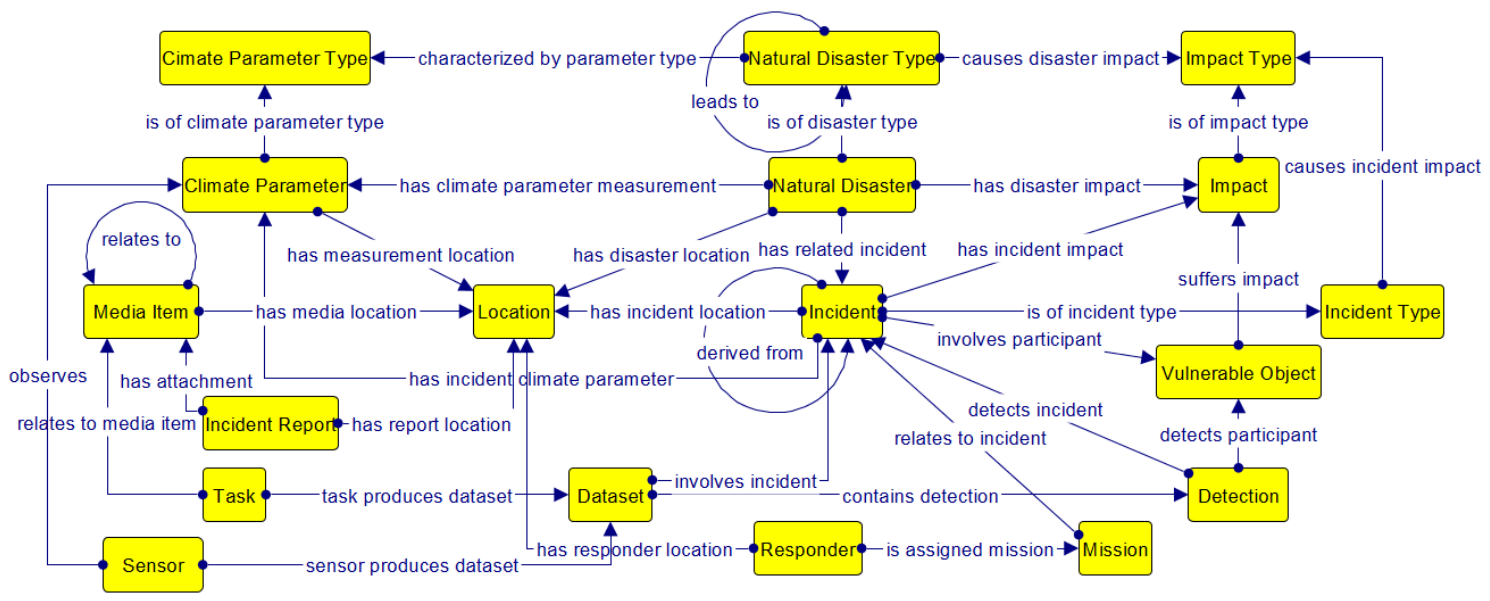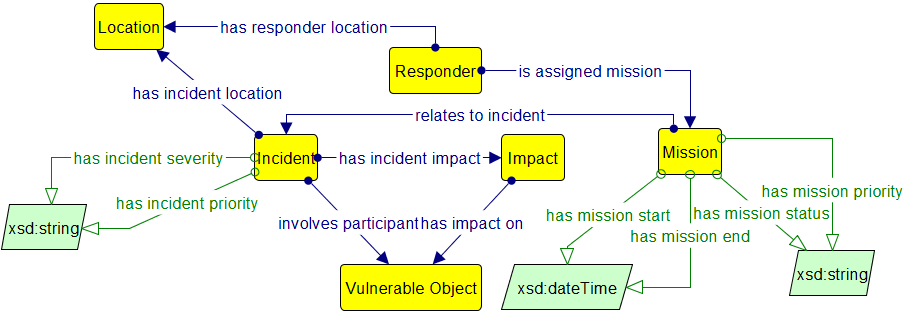The crisis management ontology of BEAWARE
The beAWARE ontology is an “all-around” lightweight crisis management ontology for climate-related natural disasters and represents the following key aspects:
- Information relevant to climate-related natural disasters;
- Analysis of data from multimodal sensors;
- Rescue team assignments.
The figure below displays an overview of the core ontology classes; for simplicity, data type and inverse properties are omitted, as well as extensive class hierarchies.

Representing Natural Disasters
The representation of climate-related natural disasters in the beAWARE ontology is illustrated in the following figure.

Class Natural Disaster Type represents the various types of disasters, e.g. floods, forest fires, storms or earthquakes etc. Disasters may lead to other disasters (via property leads to); for instance, a heat wave may lead to forest fires, or storms may lead to floods. Each type of disaster is characterized by certain climate parameters, represented via class Climate Parameter Type.
Representing Analyzed Data
The beAWARE ontology also encompasses information relevant to the analysis of input data coming from various sensors. The following figure illustrates the core constructs for representing the information fed to the ontology from the analysis components.

Class Media Item represents an item of analyzed data, which is related to some analysis task (via class Task). Media items can be pieces of text, images, videos, or social media posts, all of them submitted during the occurrence of the crisis. The analysis of the respective items (text analysis, image analysis or video analysis) produces a Dataset containing all relevant information (e.g. an object detection task may produce a dataset of detected incidents, objects, and confidence scores).
Representing Rescue Team Assignments
The third component of the beAWARE ontology is responsible for semantically representing rescue team assignments. The following figure displays the respective concepts in the proposed ontology. First responders (class Responder) are assigned one or more missions (class Mission), which in turn relate to incidents that involve participating entities (class Vulnerable Object). A mission is also characterized by start and end time, status and mission priority.

The beAWARE ontology expressed in OWL 2. For developing and deploying the ontology we relied on the following tools:
- Protégé-OWL v5.0, the popular ontology development environment;
- GraphDB for locally hosting test versions of the ontology;
- SPARQL served as the semantic query language for submitting queries to the ontology and running rules on top of the model;
- YASGUI for formalizing the SPARQL queries.
License
Apache License 2.0
Publications
- Kontopoulos, E., Mitzias, P., Moßgraber, J., Hertweck, P., van der Schaaf, H., Hilbring, D., Lombardo, F., Norbiato, D., Ferri, M., Karakostas, A., Vrochidis, S., and Kompatsiaris, I. (2018). Ontology-based Representation of Crisis Management Procedures for Climate Events. 1st International Workshop on Intelligent Crisis Management Technologies for Climate Events (ICMT 2018), collocated with the 15th International Conference on Information Systems for Crisis Response and Management (ISCRAM 2018), Rochester NY, USA, 20 May 2018.
Related Projects
- ARESIBO
- INGENIOUS
- beAWARE
Ontologies (links)
https://github.com/beAWARE-project/ontology
Contact
- Tasos Karakostas: akarakos@iti.gr
